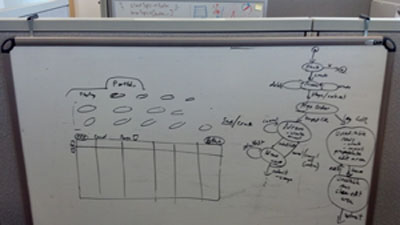
Every designer's site lies, including this one. We present these sites to visitors as if they represented all the work we do, when in my case the work represented here is probably 10% or less of what I do.
The problem is that we want to present work that has polish, finished designs. Polished designs look best and are neatest, easiest to understand, and convey a designer's abilities. But nobody I know produces polished finished designs first, let alone all the time.
Start from Rough
The image on this page is much more typical of my day-to-day work. It's an actual (phone camera) snapshot from a design session I ran with myself, a coder, and a couple of other project participants. In this case we were trying to redesign a complicated form dialog and had to consider the different ways that users could get to this form as well as the various behaviors it could have once invoked.
On the left is my rough sketch of the form design - the top part has input widgets on a tabbed pane; the bottom part is basically a grid. On the right of the board is the state diagram we collaboratively drew to show the major states of the form, what inputs users might give it, and how it would change its appearance and behavior in response. We used a state-transition diagram because that was a tool the developer was comfortable interpreting. Part of what I do is customize my presentations of design so they best reach the intended audience.
Designers sites lie because they omit these rough work products. I carry around a sketchbook and fill it with scribbles and jots. I use whiteboards and draw quickly on them. But mostly I can't show that work online.
Fail Early, Fail Often
The other little lie that designer's sites tell is that they only show successes. Project that end with successful designs are great. But my sketchbook is full of designs that never went anywhere, designs that were too confusing, designs that didn't meet the requirements, designs that I thought were great but utterly baffled our test users.
At the MIT Media Lab I learned the informal motto: fail early, fail often. This means we accept that failure is inevitable, and we know that failing early is cheaper - often orders of magnitude cheaper - than failing late in a project. Most designs are failures and don't make it onto designers' Web sites. In my FIX console design example I tried to show how our initial design failed, and how we learned from and improved after that failure.
I'm not proud of that or any other of my failures. But I am proud of my ability to use failure as a tool to making my successes better and I hope you'll understand if this site, like other designers' sites, shows mostly what I did right and forgive me my little lies.

